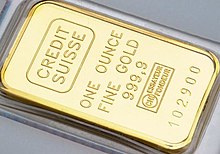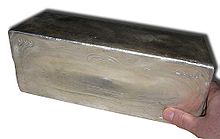Troy ounce


The troy ounce (oz t) is a unit of imperial measure. In the present day it is most commonly used to gauge the weight of precious metals. One troy ounce is nowadays defined as exactly 0.0311034768 kg = 31.1034768 g. There are approximately 32.1507466 troy oz in 1 kg. One troy ounce is equivalent to approximately 1.09714 avoirdupois ounces.
The troy ounce is part of the troy weights system, many aspects of which were indirectly derived from the Roman monetary system. The Romans used bronze bars of varying weights as currency. An aes grave weighed equal to 1 pound. One twelfth of an aes grave was called an uncia, or in English an "ounce". Later standardization would change the ounce to 1/16 of a pound (the avoirdupois ounce), but the troy ounce, which is 1/12 of a troy pound (note that a troy pound is lighter than an avoirdupois pound), has been retained for the measure of precious metals. At 480 grains, the troy ounce is heavier than the avoirdupois ounce, which weighs 437.5 grains. A grain is 64.79891 milligrams (mg); hence one troy ounce is 31.1034768 grams (g) (exact by definition), about 10 percent more than the avoirdupois ounce, which is 28.349523125 g (exact).[1][2]
To maintain purity standards and common measures across time, the troy ounce was retained over the avoirdupois ounce in the weighing and pricing of gold, platinum, silver and gunpowder. Likewise, the grain, identical in both the troy and avoirdupois systems, is still used to measure arrow and arrowhead weights in archery along with projectile (bullet) and propellant (powder) weights in ballistics. The troy ounce and grain were also common to the apothecaries' system long used in medicine, but have been largely replaced by milligrams.[3]
Etymology
The name "troy" is first attested in 1390. Though it is often connected to a fair at the city of Troyes, France,[4] this story may have been invented in the 18th century.[5]
US History
The troy ounce in use today is essentially the same as the British Imperial troy ounce (1824-1971), adopted as an official weight standard for coinage by Act of Congress on May 19, 1828.[6] The British Imperial troy ounce (known more commonly simply as the imperial troy ounce) was based on, and virtually identical with, the pre-1824 English troy ounce and the pre-1707 English troy ounce. (1824 was the year the British Imperial system of weights and measures was adopted, 1707 was the year of the Act of Union which created the United Kingdom of Great Britain.) The English troy ounce was officially adopted for coinage in 1527. Troy ounces were used in the private sector in England since about 1400. Prior to that, various sorts of troy ounces were in use on the continent.[5]
See also
References
- ^ "Troy Ounce". Troy Ounce: What is a Troy Ounce?. Retrieved 2009-08-31.
{{cite web}}: Unknown parameter|name=ignored (help) - ^ "Statutory Instrument 1994 No. 2867: The Units of Measurement Regulations 1994". Retrieved 2010-01-10.
- ^ "Troy Ounce". WordNet 3.0, Dictionary.com. Princeton University. Retrieved 2008-01-10.
- ^ Oxford English Dictionary, Second edition, 1989; online version September 2011
- ^ a b Zupko, Ronald Edward (1977). British Weights and Measures: A History from Antiquity to the Seventeenth Century. University of Wisconsin Press. p. 28-9. ISBN 978-0299073404.
- ^ Hallock, Wade (1906). Outlines of the evolution of weights and measures and the metric system. The Macmillan company. p. 119.
